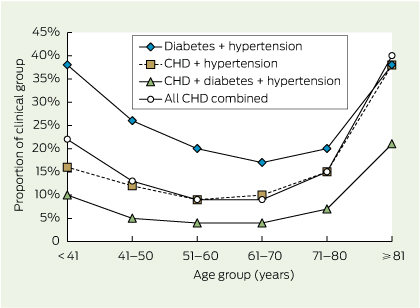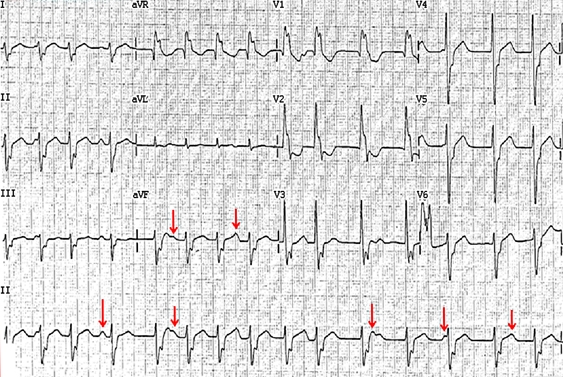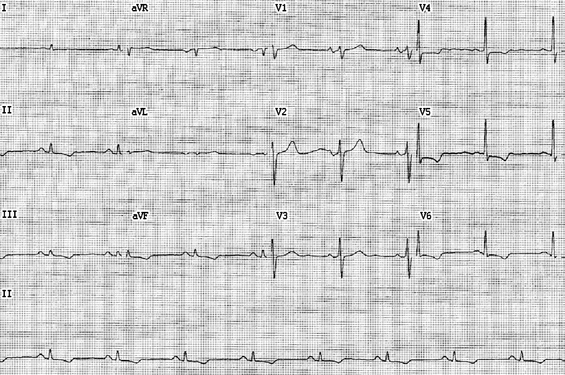Chronic heart failure (CHF) remains a major public health problem. CHF is not a static syndrome; individuals with CHF are at high risk of progressive cardiac dysfunction resulting in either sudden cardiac death or acute hospitalisation. Despite significant advances in CHF management, clinical outcomes are poor and associated with escalating health care costs.1 Worldwide, there are an estimated 23 million people living with CHF and 5.7 million new cases each year.2 With limited Australian data available, the Australian Institute of Health and Welfare has used overseas rates to suggest that 30 000 patients are diagnosed with incident heart failure annually and 300 000 people are living with CHF in Australia.3 The prevalence of CHF continues to rise as the population ages and survival from cardiovascular disease continues to improve.
Between 2006 and 2011, deaths from CHF in Australia rose by 20%.4 CHF prognosis remains poorer than that for common forms of cancer (in terms of individual survival and population life-years lost) for men and women.5,6 Hospital separations for CHF increased by 24% between 2002–03 and 2011–12.7 In the 2007–08 financial year, CHF was a primary diagnosis in 45 212 hospitalisations and a contributory diagnosis in 94 599 hospitalisations.8
The annual cost of CHF in Australia has been estimated at over $1 billion per year, with hospital care being the largest expenditure.9 A significant proportion of this cost is associated with preventable CHF readmissions. Readmissions within 30 days of discharge can be as high as 20%–27%.10,11 Overall, reported rates for readmission with CHF within 3–12 months of initial discharge are between 29% and 49%.12,13
Given the high rate of readmissions, there is profound potential to improve CHF-related outcomes, at both individual and societal levels, through improved quality of care and system change.14
Practice gaps
Recent studies have highlighted significant variations in access to evidence-based care for patients with CHF.15–17 Many individuals are not diagnosed in a timely manner and subsequent management is suboptimal. Initial diagnostic delay is often due to under-recognition of early heart failure symptoms. This is compounded by limited availability of public sector services, particularly in rural and remote areas. Additionally, patient data are not shared across health services, largely due to lack of integrated information systems and care coordination.
These problems are amplified among marginalised populations. CHF is 1.7 times more common, and occurs at a younger age, among Aboriginal and Torres Strait Islander peoples than among other Australians.18 Aboriginal and Torres Strait Islander peoples are also more likely to die from CHF, and their rate of preventable CHF-related hospitalisations is three times higher than for non-Indigenous Australians.18 Such health disparities frequently occur due to poor access to evidence-based care. Availability of culturally appropriate services that provide earlier prevention, detection and management of CHF needs to be improved.
Among people hospitalised with CHF, those who receive evidence-based, multidisciplinary care have better health outcomes than those who do not.19,20 Current Australian guidelines articulate the evidence-based practices necessary to improve care delivery.21 However, the management of CHF remains a pressing concern, with many apparent indicators of poor case detection, non-guideline-based management, poor coordination and communication, and recurrent hospital admission.15–17,22
In this consensus statement, our aim is to guide the policy and associated system changes required to support delivery of evidence-based care. This is not intended as a prescriptive guideline, rather a set of principles to assist health departments, health network administrators, clinicians and consumers in improving care systems for people living with CHF. Our intended audience is policymakers, health system managers, consumers and health professionals in acute and primary care, including cardiologists, general practitioners, nurses, dietitians and other members of the multidisciplinary team. The consensus development process is outlined in Box 1.
The expert panel identified four themes and five principles to inform the consensus statement (Box 2). The recommendations (Box 3) based on these themes have the potential to reduce the likelihood of emergency presentations, hospitalisations and premature death among patients with CHF.
Chronic heart failure care model
Best-practice management of CHF involves evidence-based, multidisciplinary, patient-centred care, which leads to better health outcomes.20,23 Patient-centred care is respectful of and responsive to preferences, needs and values of patients and consumers and should include dimensions of respect, emotional support, physical comfort, information and communication, continuity and transition, care coordination, involvement of family and carers, and access to care.23 Greater care coordination is needed because fragmentation across health care, long-term care and other social support systems effectively impedes a patient-centred focus.24 Research suggests that providing incentive payments through primary care payment schemes may improve care continuity and transition, as would streamlining funding for delivery of different levels of care.24
Multidisciplinary CHF care is distinguishable from generic chronic disease management programs by the special needs of these patients, which necessitate specialised evidence-based treatment strategies associated with optimal outcomes.25,26 Considerations include management of severely ill CHF patients, symptom monitoring, implementation of a range of self-management strategies and titration of medications.
Against a background of recent national health reform linking improved person-centred care with performance and funding arrangements, there is increasing interest in how to realign care systems accordingly. Research suggests that individuals value easy access to services, coordinated care, and information and honesty about their prognosis.27,28 Patient or consumer charters and informed consent policies have been introduced, but there is limited evidence that consumer engagement influences change in care delivery.29 Consumer engagement has been strengthened by the recent introduction of the National Safety and Quality Health Service Standards, which include a component on consumer partnership.30 The Standards deliver a framework that health organisations can use to actively engage and partner with consumers to strengthen health service delivery.30
Research suggests care coordination problems are greatest at the interfaces between health care sectors and between providers.24 Multidisciplinary care can overcome some of these barriers, as can pooling resources between sectors for care coordinators.24 Multidisciplinary program delivery needs to be appropriate to local needs, resources, patient preferences and disease trajectory phase, as well as across a range of delivery models, including home-based, clinic-based and telephone-based approaches, or a hybrid of these.17,31,32
CHF management plans that include a multidisciplinary approach are vital to educate and empower individuals and their carers to manage this challenging condition.11,33 Given limited resources, a risk assessment tool that stratifies patients at higher risk of readmission could be used to ensure those most likely to benefit from a management program are targeted.34 These plans should be clear about responsibilities among health care providers.
There are cardiac clinical networks in most Australian states and territories (Queensland, New South Wales, Victoria, South Australia, Western Australia, Northern Territory) that have championed access to evidence-based care for CHF patients. These networks have significant influence in improving care systems and outcomes, and can evaluate variance in care quality within and across jurisdictions, with the authority to develop funding models, including care packages. They can facilitate improvements in CHF care by fostering awareness, communication, partnerships and links; by engaging leaders across sectors; and by providing advice and advocacy for policy, planning and funding. The expert panel identified the clinical networks’ essential role in ensuring systematic delivery of a multidisciplinary care model, and concluded this role should be strengthened and further developed. Although multidisciplinary CHF management programs exist across Australia, ensuring access for all patients who would benefit remains a challenge. This is particularly so for Aboriginal and Torres Strait Islander peoples, those from non-metropolitan areas and lower socioeconomic backgrounds, and culturally and linguistically diverse populations.16,35
Implementation of patient-centred care approaches can also have clinical and operational benefits, through less frequent readmissions and improved clinician and patient satisfaction.36–38 Other benefits include reduced emergency department re-presentations, fewer medication errors, higher functional status and improved evidence-based clinical care.38,39 There continues to be a large degree of heterogeneity between CHF programs,40 with some delivering high-quality complex care and others a simplistic program with minimal interventions. Research has shown that this has an impact on patient outcomes,41 and national guidelines have been developed to reduce this heterogeneity in Australia.21 Minimum accreditation standards are important for assessing multidisciplinary care services and reporting on best practice.16,42
Access to meaningful data for management and benchmarking
There is a paucity of Australian data on CHF, resulting in reliance on extrapolation of overseas research. Lack of identification of people with symptomatic CHF prevents efficient patient monitoring. Expansion of cardiac registries to include patients with CHF could improve identification. Recall between health care providers to ensure appropriate assessments and treatments are completed at pre-agreed intervals is also often uncoordinated. An electronic health record potentially offers the ideal tool to track, document and supply CHF patients or their carers and health care providers with the appropriate health care information, on demand, to optimise care.
Further, we do not have standardised outcomes to measure and evaluate care effectiveness and enable international and national benchmarking activity. The definition of a quality indicator must be specific, complete, clearly worded and verified across different user groups.43 Another barrier to measuring standardised outcomes is poor data system compatibility across and within health services, which prevents efficient transfer of data and results in duplication of patient data collection. These problems could be reduced through the use of better process measures.
Increasingly, hospital readmission is becoming an important indicator of health care outcomes, as it can be used to identify potentially preventable admissions. However, as a sole indicator, it can be problematic due to difficulties with interpretation, utility in the clinical environment, and problems such as poor attendance at outpatient clinics, which does not necessarily reflect poor hospital care. An operational definition for readmission needs to clearly identify the diagnosis-related group or major disease classification associated with the index admission.
Over a longer period, as readmissions occur due to the chronic nature of the disease, event-free survival provides a measure of quality.44 An event is defined as an emergency presentation, hospitalisation or premature death within any 12-month period.45
Workforce planning
Workforce needs are likely to be driven by the ageing population and associated disability rates, as well as changing technology, increased burden of disease and community expectations.46
One of the main challenges to workforce planning is providing access to services outside large cities. In 2006, Australian capital cities hosted 93% of CHF management programs, despite 40% of the known population with CHF living outside these cities.47 Policies that guide specialisation or multiskilling in the health workforce will become increasingly important.48
GPs should be empowered to lead care for patients with CHF. This may be through the introduction of funding incentives or provision of nurse practitioners and practice nurses in primary care. Any incentive arrangements should favour provision of care for Aboriginal and Torres Strait Islander peoples, those from lower socioeconomic backgrounds and rural areas, and culturally and linguistically diverse populations.49
Research
Future research activity needs to build in processes to ensure the dissemination and translation into practice of valuable knowledge; the creation of ethical and evidence-based research policies; and the promotion, monitoring and implementation of high-quality health research evidence.
Research and quality improvement activity priorities arising from this consensus statement are those relating to CHF care models (including development of readmission risk assessment models), access to meaningful data for management and benchmarking, and workforce planning. Focused investigative teams, such as clinical CHF research networks, could lead this work. In addition, more work needs to be undertaken among populations for whom frequent access to mainstream services is limited; namely Aboriginal and Torres Strait Islander peoples, those from non-metropolitan areas and lower socioeconomic backgrounds, and culturally and linguistically diverse populations.
Individuals with CHF have specific management needs. Future research should consider roles of specialty care teams (eg, cardiology, general medical) and the role of telehealth.
Conclusion
The current and future burden of CHF compels us to strive for equitable outcomes for all Australians. A national policy framework, with agreement between states, territories and the federal government, needs to be developed and implemented to tackle the increasing burden of CHF. Governments at national and state levels, together with cardiac clinical networks, need to ensure that evidence-based care models for people with CHF are standardised, with equitable access.
The core principles and recommendations described in this consensus statement should be incorporated into the various CHF systems of care operating across states and territories. Implementing these recommendations has the potential to improve the quality of care provided to individuals with CHF, reducing associated costs for both the individual and the community. Improvements could be seen not only in the care experienced by patients and their families, but also in clinical and operational benefits. Implementing multidisciplinary, patient-centred care approaches can shorten lengths of stay in hospital, reducing health care costs and improving clinician and patient satisfaction.22,44,45,50 In the longer term, other benefits of patient-centred care include reduced emergency department re-presentations, fewer medication errors, higher functional status and improved clinical care.40–42
These recommendations can empower health care providers and organisations, peak and government organisations, care regulators, education providers and consumers to improve health outcomes for patients with CHF and to reduce harm. This work needs to be underpinned by nationally recognised standards for outcome measurement that are universally recognised and easily applied in practice. Data systems need to support evidence-based decision making, while providing feedback relating to standardised performance measures. Our health care workforce needs to be equipped to deal with the increasing burden of disease associated with CHF, with training, education and research around the delivery of multidisciplinary care in an increasingly complex environment.
These recommendations, if adopted, have the potential to facilitate and promote optimal and equitable health outcomes for all Australians diagnosed with CHF.
1 Consensus development process
The National Heart Foundation of Australia convened an expert panel to provide guidance on policy and system changes to improve the quality of care for people with chronic heart failure. A relevant literature search was performed, limited to evidence from human studies published in English between 2003 and 2013. This was complemented with hand searching of reference lists from reviews and personal collections of the expert panel, and additional peer-review. As there is limited evidence around the system changes required, these consensus recommendations are based on expert opinion. They are not exhaustive, and many other changes and actions can be implemented by both individuals and organisations to improve care outcomes. The recommendations are generally broad, rather than prescriptive, and many can be implemented with minimal resourcing.
2 Themes and principles to reduce emergency presentations, hospitalisations and premature death among patients with chronic heart failure (CHF)
|
Theme
|
Principle
|
|
|
CHF care model
|
Current evidence clearly identifies that accessible, multidisciplinary, guideline-based CHF care improves outcomes.
|
|
Access to meaningful data for management and benchmarking
|
Collecting outcome data is the only accurate way of determining the effectiveness and cost of individual treatments; practice standards can then be based on up-to-date comparative effectiveness research.
Adequate patient information is a prerequisite for reducing unnecessary hospital admissions and medical errors.
|
|
Workforce planning
|
An appropriately trained workforce with access to specialist cardiology support can deliver evidence-based care.
|
|
Research
|
Research is essential to ensure an evidence base.
|
3 Recommendations to achieve a systematic approach to chronic heart failure (CHF) care*
CHF care model
1. Through state and territory cardiac clinical networks, support health departments to continue leading the development of integrated local care systems and future national quality improvement strategies within and across health services.†
2. Identify and implement mechanisms to champion the uptake of clinical practice guidelines and delivery of integrated CHF services, according to local population need, within and across health services.†
3. Develop minimum standards for CHF multidisciplinary care, which can be used to accredit health services and recognise best-practice health services or networks.
4. Develop robust funding models and examine the role of funded care packages in CHF care.
5. Establish system protocols and pathways to ensure effective clinical handover and service coordination across care transitions, and to activate appropriate services according to clinical need for an exacerbation, emergency presentation, hospitalisation or palliation.
6. Streamline care processes to facilitate early diagnosis, self-management and multidisciplinary care planning, including primary care involvement and appropriate access to palliative services.
7. Embed mechanisms to promote the rights of individuals and their carers to facilitate their active engagement with health professionals and care systems.
Access to meaningful data for management and benchmarking
8. Develop national data definitions for CHF.
9. Expand current cardiac registries to include patients with CHF.
10. Develop mechanisms to promote data linkage across care transitions.
11. Trial an electronic health record for people diagnosed with CHF, so all current and future health care providers could, with the individual’s consent, have access to the same information where and when they need it.
12. Use 12-month event-free survival as an outcome measure nationally to evaluate effectiveness of care systems. Events would include emergency presentations, hospitalisations and premature death.
13. Establish a national mechanism for monitoring and reporting CHF care outcomes against a nationally recognised set of goals and standards.
14. Develop a national set of indicators and standards to evaluate, inform and improve systems of care.
Workforce planning
15. Develop the workforce capacity across hospital and community services to deliver evidence-based care, appropriate to the local population, as identified in Guidelines for the prevention, detection and management of chronic heart failure in Australia31 and Multidisciplinary care for people with chronic heart failure: principles and recommendations for best practice.21
16. Develop robust funding models for the delivery of these services.
17. Examine mechanisms to empower general practitioners and other health care professionals in primary care to deliver evidence-based care for people with CHF.
Research
18. Create investigative teams, such as clinical CHF research networks, with active consumer collaboration.
19. Investigate approaches to optimise care delivery for Aboriginal and Torres Strait Islander peoples, those from non-metropolitan areas and lower socioeconomic backgrounds, and culturally and linguistically diverse populations.

 more_vert
more_vert

